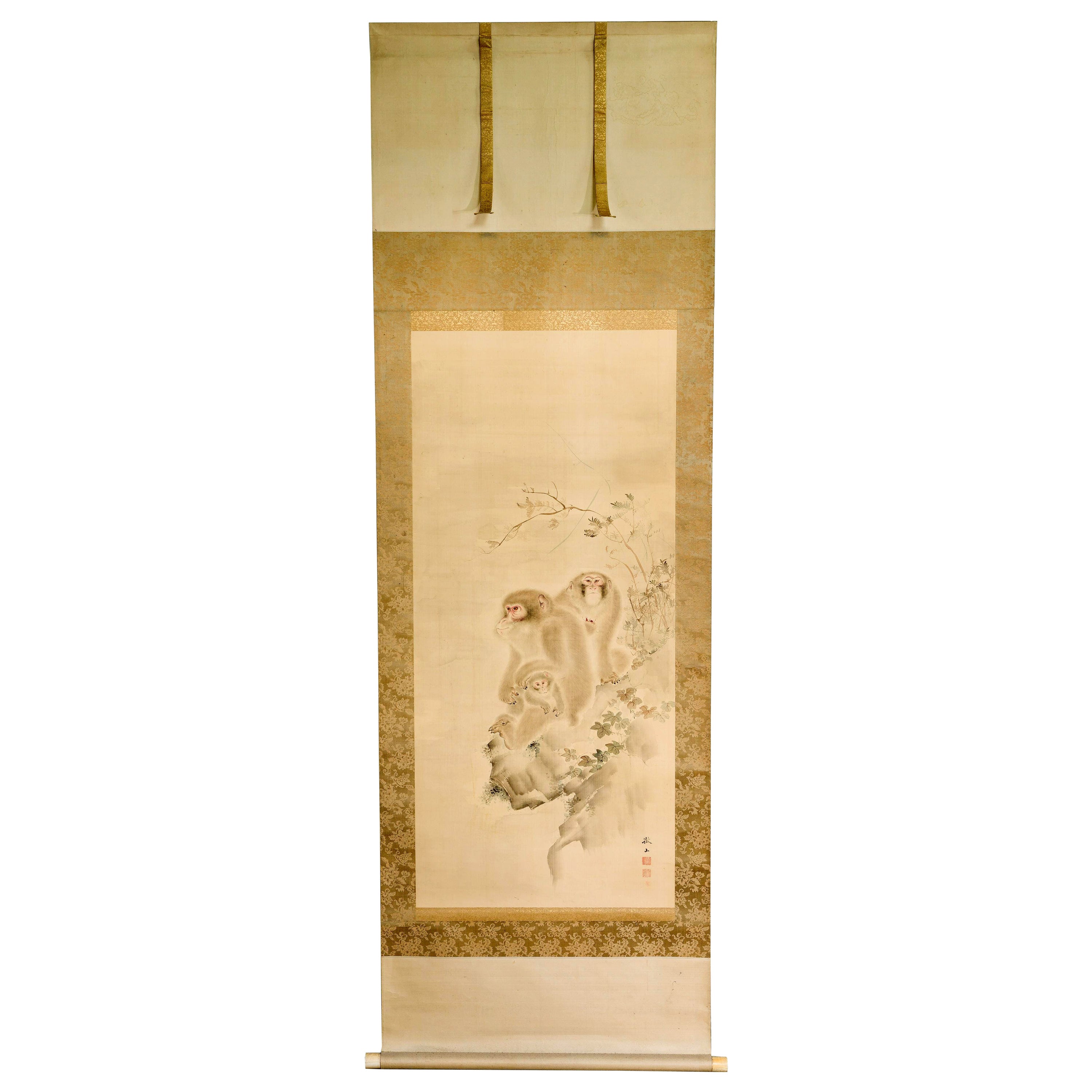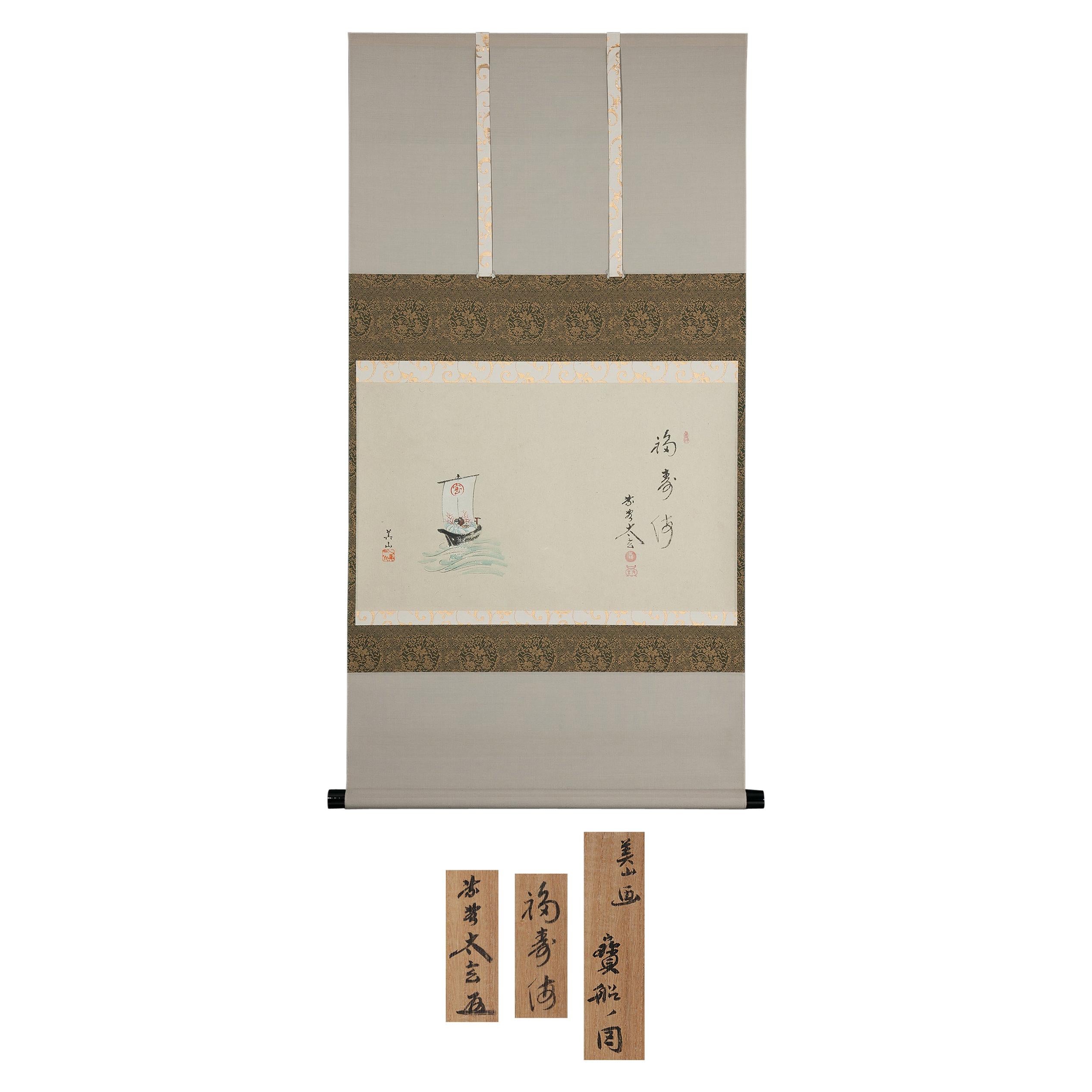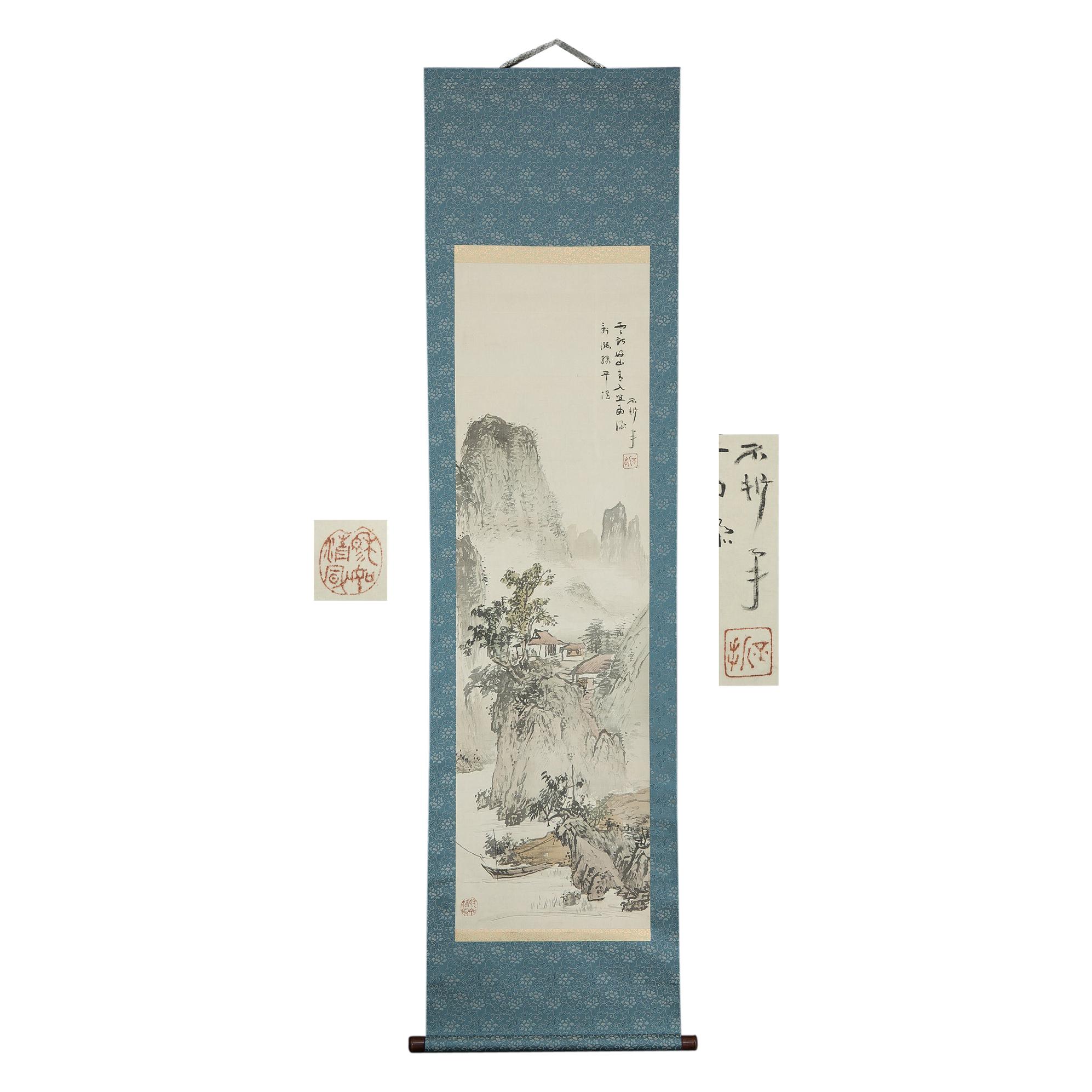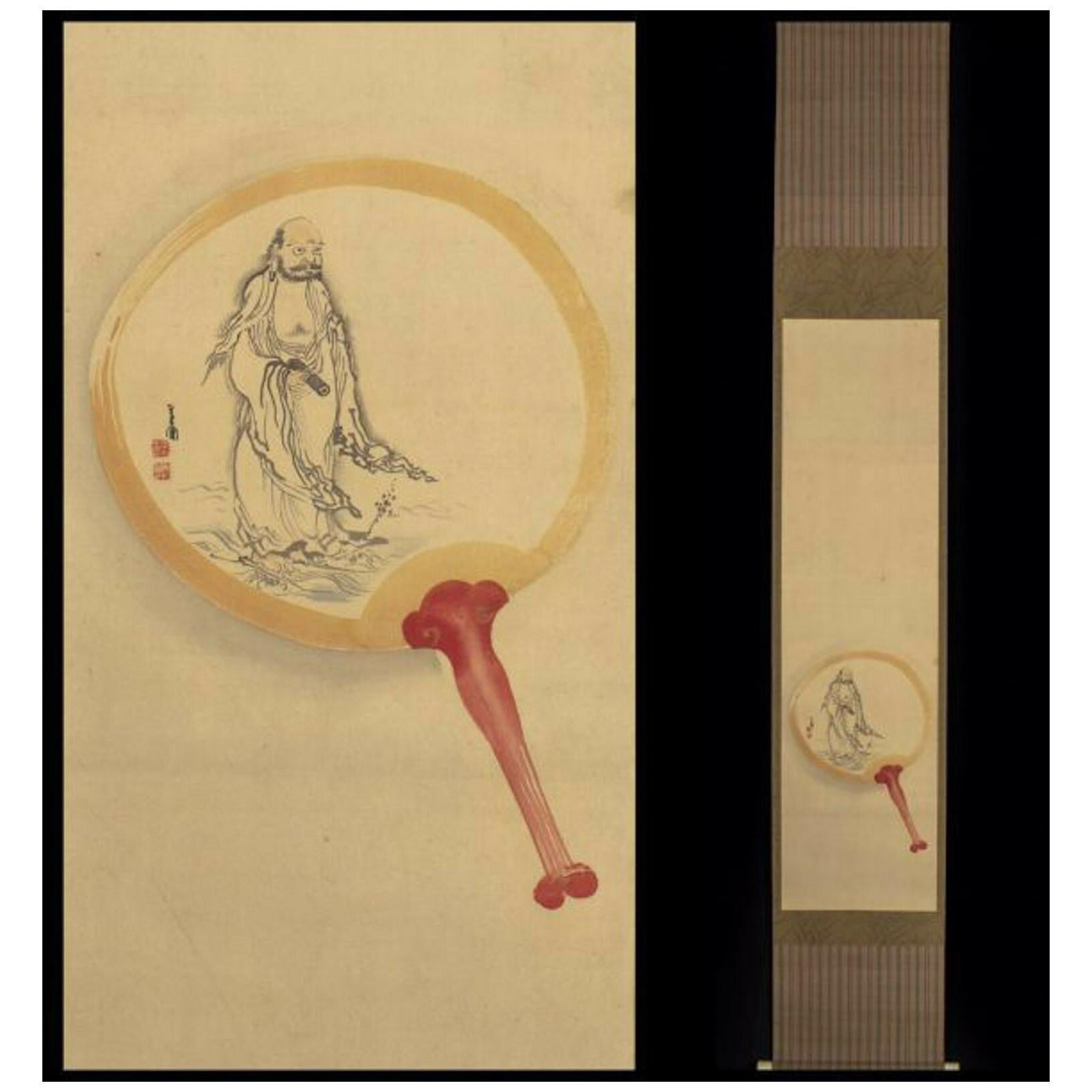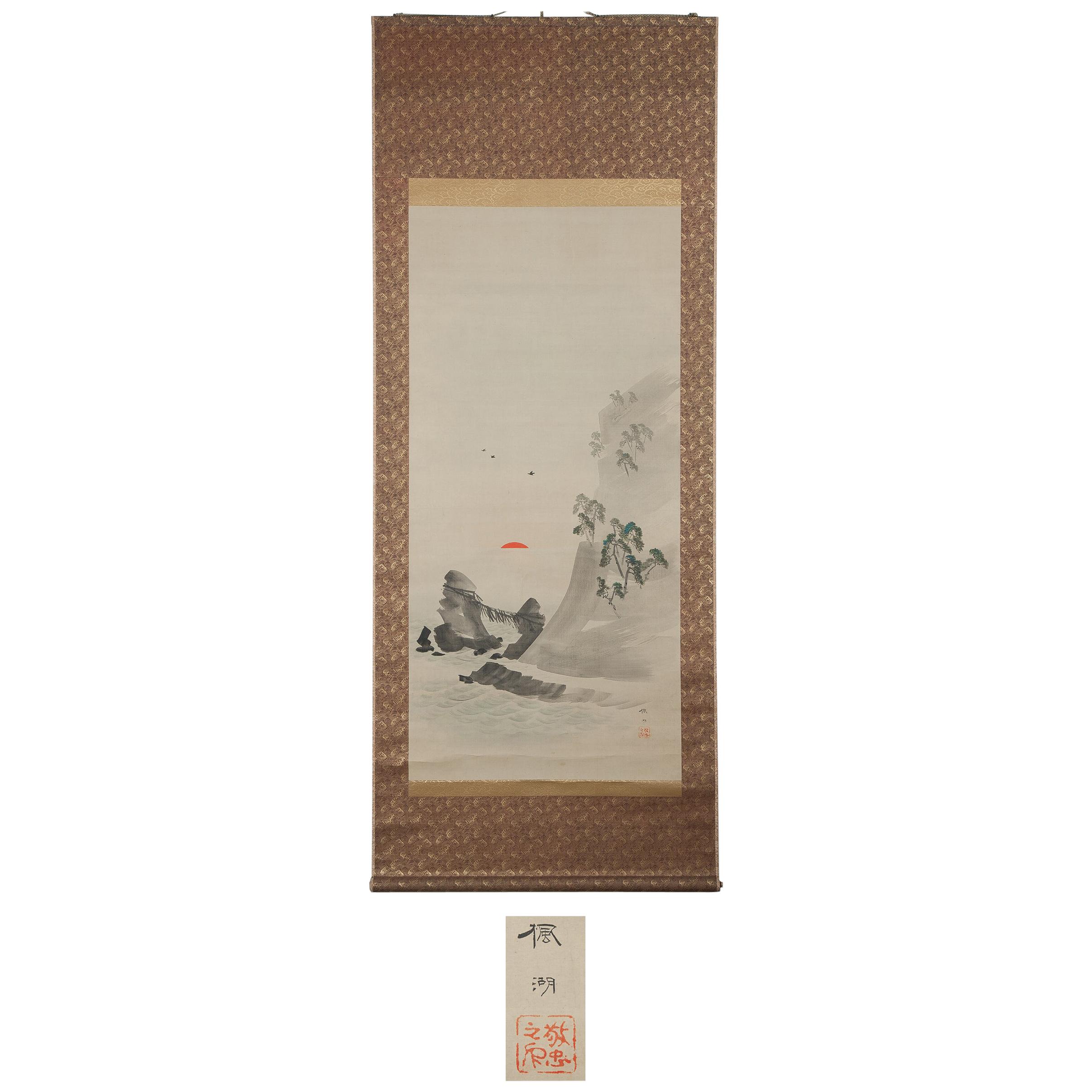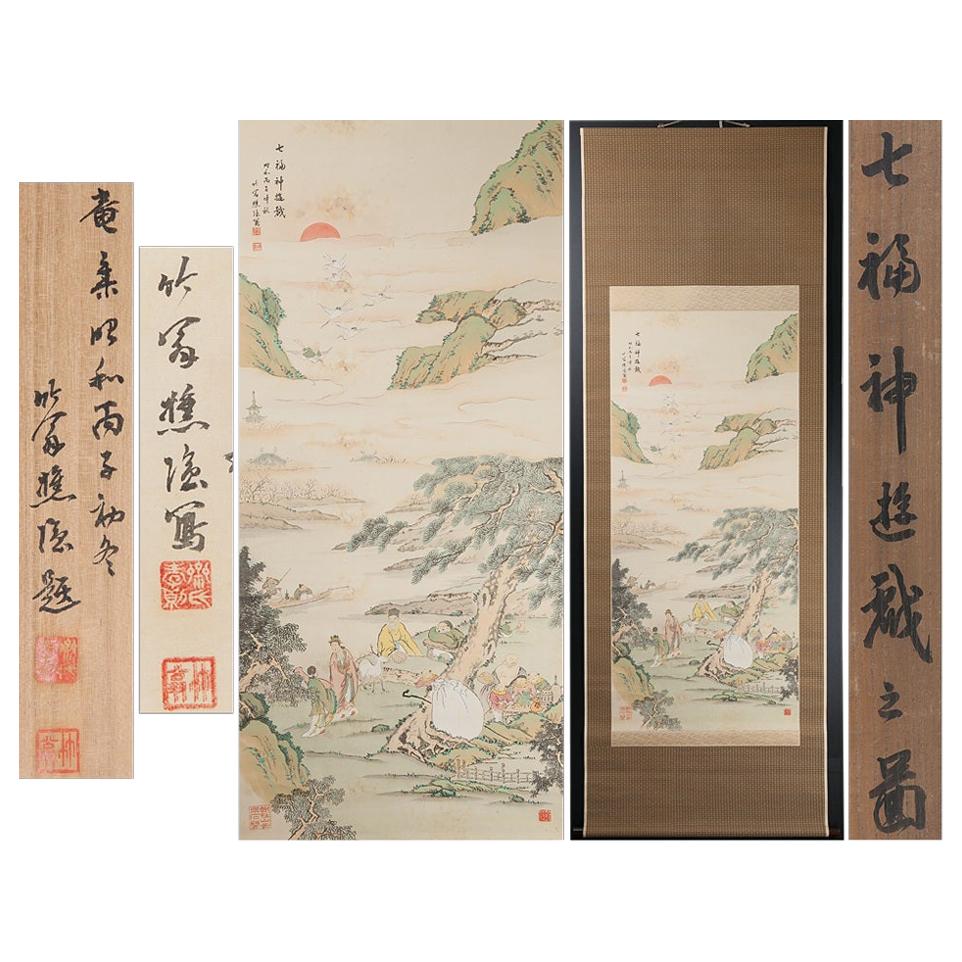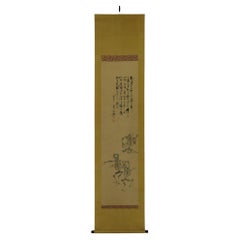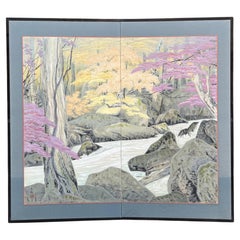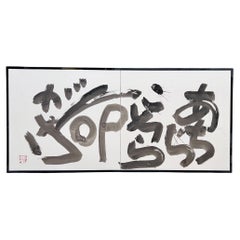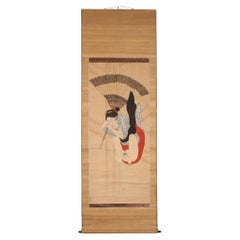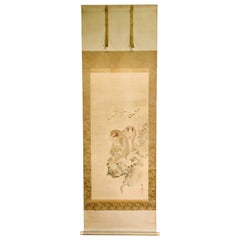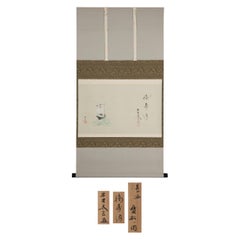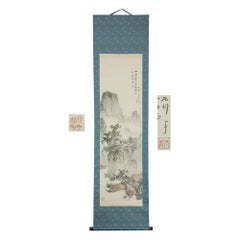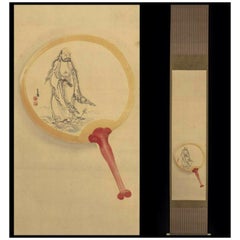Items Similar to Rare Japanese painting, Skeletons Studying, Shaku Kaiyin, Japan Meiji Period
Want more images or videos?
Request additional images or videos from the seller
1 of 6
Rare Japanese painting, Skeletons Studying, Shaku Kaiyin, Japan Meiji Period
$1,795.81
$2,244.7620% Off
£1,346.07
£1,682.5920% Off
€1,520
€1,90020% Off
CA$2,467.13
CA$3,083.9220% Off
A$2,754.32
A$3,442.9120% Off
CHF 1,443.22
CHF 1,804.0320% Off
MX$33,715.63
MX$42,144.5420% Off
NOK 18,328.96
NOK 22,911.2020% Off
SEK 17,281.89
SEK 21,602.3620% Off
DKK 11,570.79
DKK 14,463.4920% Off
About the Item
Skeletons Studying, Shaku Kaiyin, Japan Meiji Period
This ink-on-paper painting, mounted as a scroll with colored paper borders, is titled Skeletons Studying. It portrays a circle of skeletons seated around a teaching master, creating a scene that is both whimsical and philosophical. The skeletons, robed like monks, sit attentively, listening to their mentor in the center. The circular composition symbolizes equality and unity in the pursuit of spiritual truth. Despite its caricature-like appearance, the piece reflects a concept akin to European vanitas—a meditation on the ephemeral nature and superficiality of the body in contrast to the eternal spirit.
Liu Chao, also known as Shaku Kaiyin, was a Japanese monk from Tokoname active during the Meiji era. In addition to his paintings, he authored numerous educational manuals published in Tokyo, such as the Japanese Complete Maps Guidebook and the Bankoku Geographical Summary. He initially served as the head of a public primary school before dedicating himself to Buddhist reform, collaborating with scholars Fumio Nanjo and Enryo Inoue to co-found the reflection circle “Ho no Tomo.” Toward the end of his life, Liu Chao specialized in painting skeletons, employing this imagery to convey Buddhist messages on the emptiness of appearances and spiritual liberation.
Good overall condition, with minor stains or creases visible in the photos, and a repair in the upper part of the mounting.
Dimensions: 206 x 58 cm (scroll), 139 x 47 cm (painting only)
Includes a storage box.
- Dimensions:Height: 81.11 in (206 cm)Width: 22.84 in (58 cm)Depth: 1.19 in (3 cm)
- Materials and Techniques:
- Place of Origin:
- Period:
- Date of Manufacture:1890
- Condition:Good general condition with old wears to the mounting. Additional pictures can be sent.
- Seller Location:PARIS, FR
- Reference Number:1stDibs: LU6491242494892
About the Seller
5.0
Recognized Seller
These prestigious sellers are industry leaders and represent the highest echelon for item quality and design.
Established in 1982
1stDibs seller since 2022
6 sales on 1stDibs
- ShippingRetrieving quote...Shipping from: PARIS, France
- Return Policy
Authenticity Guarantee
In the unlikely event there’s an issue with an item’s authenticity, contact us within 1 year for a full refund. DetailsMoney-Back Guarantee
If your item is not as described, is damaged in transit, or does not arrive, contact us within 7 days for a full refund. Details24-Hour Cancellation
You have a 24-hour grace period in which to reconsider your purchase, with no questions asked.Vetted Professional Sellers
Our world-class sellers must adhere to strict standards for service and quality, maintaining the integrity of our listings.Price-Match Guarantee
If you find that a seller listed the same item for a lower price elsewhere, we’ll match it.Trusted Global Delivery
Our best-in-class carrier network provides specialized shipping options worldwide, including custom delivery.More From This Seller
View AllWunderkammer, The Dance of the Skeletons, by Tanomura Chokunyu (1814-1909)
Located in PARIS, FR
The Dance of the Skeletons, by Tanomura Chokunyu (1814-1909)
This Japanese ink and pigment painting on paper, mounted on a scroll with silk borders, depicts the macabre and captivati...
Category
Antique Late 19th Century Art Nouveau Paintings
Materials
Paper
$1,701 Sale Price
20% Off
Two-panel folding screen, Nihonga, Hirai Baisen (1889–1969), early Shōwa era (19
Located in PARIS, FR
Two-panel folding screen, Nihonga, Hirai Baisen (1889–1969), early Shōwa era (1940s)
This two-panel screen is signed by Hirai Baisen (1889–1969), a major Nihonga painter who is only...
Category
20th Century Japanese Paintings and Screens
Materials
Paper
Screen Calligraphy, Risking One’s Life Here and There – Sakae Umezu (1926-2013)
Located in PARIS, FR
Screen Calligraphy, Risking One’s Life Here and There – Sakae Umezu (1926-2013)
This two-panel folding screen, created by Sakae Umezu, is a powerful and expressive calligraphic work....
Category
Late 20th Century Japanese Screens and Room Dividers
Materials
Paper
Scroll paintingJapan, Woman jumping from the balcony of Kiyomizu-dera Edo period
Located in PARIS, FR
Japan, Woman jumping from the balcony of Kiyomizu-dera Edo period
Japanese scroll painting – Woman jumping from the balcony of Kiyomizu-dera temple, Edo period
Ink and pigments on pa...
Category
Antique 1790s Japanese Paintings
Materials
Paper
A Rare Large Chinese Export oil on canvas, att to Tingqua, China circa 1830
Located in PARIS, FR
Large Chinese Export oil on canvas, att to Tingqua, circa 1830
Oil on canvas attributed to Tingqua representing figures by a waterfall.
Old Christie's New York tag on the back
Origin...
Category
Antique Early 19th Century Chinese Chinoiserie Paintings
Materials
Paint
Ohashi Suiseki, Resting tiger, Japanese watercolor on silk, Japan circa 1900
Located in PARIS, FR
Ohashi Suiseki, Resting tiger, watercolor on silk, circa 1900
Midori Ohashi (Ohashi Suiseki, April 1865 -August 31, 1945 ) is a Japanese painter who was...
Category
Antique Late 19th Century Japanese Paintings
Materials
Silk
$2,117 Sale Price
28% Off
You May Also Like
Japanese Silk Scroll Painting of Moneys Edo Period Mori Tetsuzan
Located in Atlanta, GA
A Japanese mounted vertical hanging scroll painting by Mori Tetsuzan (Japanese, 1775-1841) circa 19th century Edo period. The watercolor and ink on silk ...
Category
Antique 19th Century Japanese Japonisme Paintings and Screens
Materials
Silk, Paper
Lovely 20th Century Scroll Paintings Japan Tomobako Showa Artist Kobayashi
Located in Amsterdam, Noord Holland
Great decorated piece, artist Kobayashi Futoshi Gensho (B.1938-now)
Condition:
Very good. Size: Axis, vertical 117 cm horizontal 60.5 cm, painting, vertical 35 cm horizontal 58.5...
Category
20th Century Japanese Showa Paintings and Screens
Materials
Fabric
$1,196 Sale Price
25% Off
Lovely Fusetsu NakamuraScroll Painting Japan Artist Flowers Painted
Located in Amsterdam, Noord Holland
Fusetsu Nakamura
1866-1943
of the Showa-life painter and calligrapher
Tokyo students
real name: Taro
issue: Fusetsu, Kanzan, Anakatatei, Goinoshishi teacher, long life, Reitsubotoki
...
Category
Mid-20th Century Japanese Showa Paintings and Screens
Materials
Silk
$1,559 Sale Price
20% Off
Lovely Japanese 18th-19th Century Edo or Meiji Scroll Painting Japan
Located in Amsterdam, Noord Holland
Maruyama–Shijo style painting
C0ndition; Good but some stains.
Overall dimensions: width of about 28.2 cm and Length of about 173.8 cm
Painting width of about 25.5 cm × leng...
Category
Antique 19th Century Japanese Meiji Paintings and Screens
Materials
Bronze
$661 Sale Price
20% Off
Lovely Meiji Period Scroll Paintings Japan Meiji Artist Fuko Matsumoto
Located in Amsterdam, Noord Holland
Fuko Matsumoto, order of the rising sun,
Size: Axis, vertical 212.5 cm next to 84.7 cm
Painting, vertical 140.8 cm horizontal 66.7cm ? Differs slightly in size.
Condition: The state is good, but, wrinkle-thin stain
Biography Fuko Matsumoto 1840-1923
Japan painter. Ibaraki prefecture production. Imperial Art Academy member.
Fuko was born as the 3rd son of Matsumoto Soan in Kawachi County of Hitachi Province (Now Inashiki City of Ibaraki Prefecture) on September 14 of the 11th year of the Tenpo era.
His real given name was Toshiro.
In 1853, when Fuko was 14 years old, he went to Edo and studied painting under Oki Ichiga, who was an official painter of Tottori Domain.
Ichiga was a painter who studied the Kano, the Rinpa and the Nanpin styles, and was good at expressing flowers & birds in deep colors.
Later, Fuko studied painting under Satake Eikai, who was best pupil of Tani Buncho...
Category
Antique 19th Century Japanese Meiji Paintings and Screens
Materials
Fabric
$1,107 Sale Price
25% Off
Immortals Nihonga Scene Meiji/Taisho Period Scroll Japan Artist Meiji Period
Located in Amsterdam, Noord Holland
Axis: Vertical 194 cm, Horizontal 49.5 cm
Inside: Vertical 126 cm, Horizontal 37 cm *Some errors will occur in the dimensions. Please understand.
Status I don't know the details of...
Category
20th Century Japanese Meiji Paintings and Screens
Materials
Silk
$803 Sale Price
20% Off
More Ways To Browse
Japanese Monk
Japanese Meiji Period Box
Antique Furniture Tokyo
Antique European Screen
Map Storage
Monk Robe
Meditation Seat
Asian Painted Scrolls
Antique Monks Seat
Monk Head
Buddhist Scroll
Hand Painted Antique Map
Japanese Buddhist Screen
Scroll Map
Meiji Era Screen
Antique Map Storage
Japanese Skeleton
19th Century Chinese School
